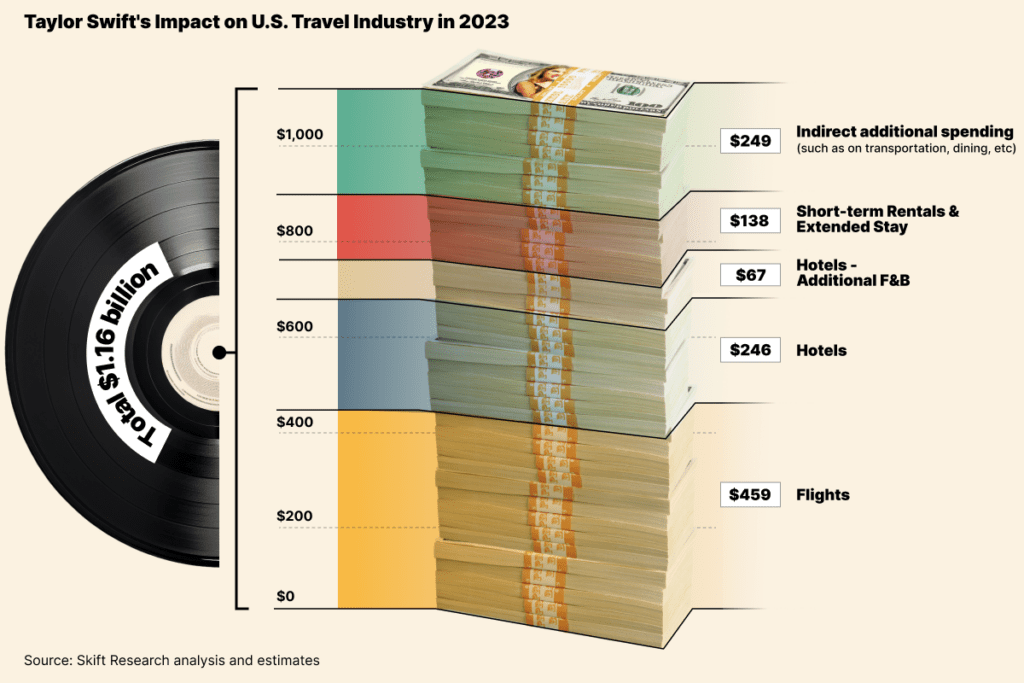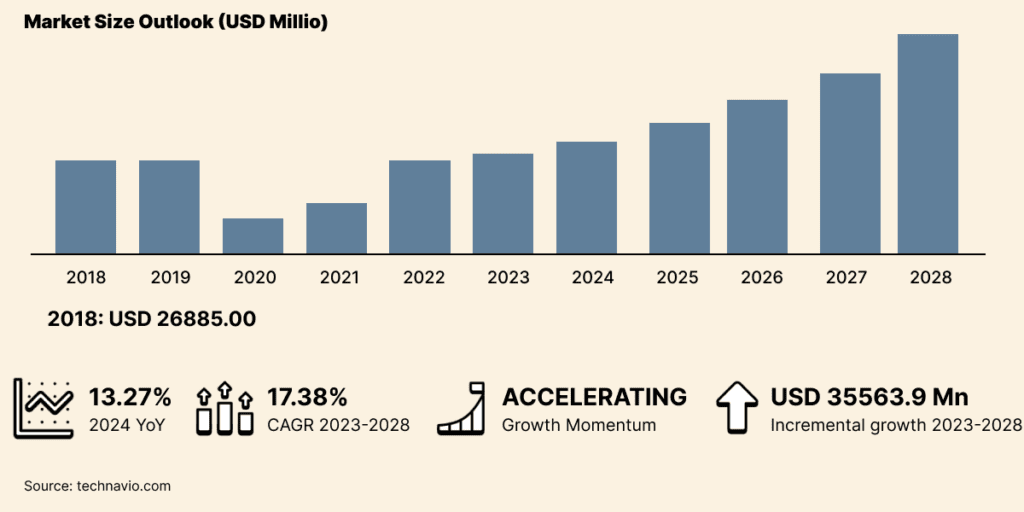[ad_1]
Picture this: You’re standing in a sea of 50,000 strangers, the air crackling with anticipation. Maybe it’s just before kick-off of the Super Bowl. Maybe the lights are finally dimming as your favorite band steps on stage. Or maybe it’s the eerie, otherworldly hush as the sky darkens and eclipse chasers look up, waiting for the universe to remind everyone that we’re all just tiny specks spinning in the dark.
Welcome to 2025, when travel isn’t just about getting a picture in front of your favorite landmark. It’s about being in the right place, at the right time, with the right people. It’s about the moments where you feel something real, something alive.
Travelers don’t book a plane ticket just to visit Paris; they go because BTS is playing in front of the Eiffel Tower – and in their bones they simply must be there.
In the next year, travelers will flock to massive spectacles that pull at our collective senses of wonder, adrenaline and nostalgia. But they’re more than just pageantry, they’re catalysts for a surging type of collective travel phenomenon – we’re calling it Live Tourism.
Beyond the Eras Era
Of course, Live Tourism has always been with us. It was there in ancient Greece when journeymen gathered for the original Olympic Games or in 1969 when travelers flocked to Woodstock. But the modern Live Tourism era really started with a pop star.
Taylor Swift – a shrewd businesswoman who transcends music – is rewiring how we think about tourism (and many other business areas as well). Her Eras Tour was a mind-bending exercise in collective excitement. Fans, and often their parents, didn’t just go to see a show; they built entire vacations around them, each one becoming a multi-day event. Travelers booked flights, found cozy Airbnbs, and gathered for a week of Taylor-fueled euphoria. Research showed concert-goers spent an average $1,300 per show on incidentals over and above the cost of tickets.

In 2025, concerts and festivals are poised for more significant growth as fans continue to cross continents to experience live music. Tours slated for 2025 include Oasis, Beyonce and Coldplay; Harry Styles and K-Pop sensation BTS are rumored.
As they did for Swifties, airlines may offer specialized packages that bundle flights with event tickets or exclusive experiences. Partnerships with event organizers will become more common, providing travelers with seamless options for attending shows. And if touchdown is just the start, up next is ground transportation. Ride-sharing companies, taxi fleets, and public transportation systems will increase capacity and improve coordination to accommodate more passengers.
The market for global live music is projected to swell by more than $35 billion between 2023 and 2028, growing at an annual rate of 17%, according to market research firm Technavio.

Show Me The Money!
Cities hosting mega-tours aren’t just staging concerts — they’re reaping economic benefits that extend to every hotel, restaurant, and venue in town. To accommodate, cities are investing in smarter transit, lodging, and public spaces.
New York City and neighboring New Jersey will prepare to host the FIFA World Cup in 2026. While accustomed to large-scale events, Gotham faces substantial infrastructural challenges to transport crowds from Manhattan to New Jersey stadiums. The eight matches in the New York and New Jersey region are expected to generate over $2 billion in economic impact, according to Nancy Mammana, NYC Tourism + Conventions Interim CEO.
This intense preparation highlights a larger trend: sports tourism is booming, projected to reach $2.1 trillion by 2030, an impressive 17.5% annual growth rate.
Events like the Olympic Games, Formula 1, the World Cup, and the Super Bowl fuel this global industry. FIFA’s 2022 World Cup in Qatar had 3.4 million fans and generated a record-breaking $5.8 billion, while Formula 1’s worldwide race circuit brought in 5.7 million attendees in 2022 — up 36% from 2019 — pushing revenues to $2.5 billion. According to the United Nations, sports tourism now represents 10% of global tourism spending.
In the U.S., the Super Bowl remains the pinnacle of annual sports tourism. Jay Cicero, President and CEO of the New Orleans Super Bowl Host Committee, is betting big on 2025’s Super Bowl LIX, aiming to deliver economic gains and cement New Orleans as a premier destination for global sports and entertainment. “New Orleans welcomes the opportunity to host our record-tying 11th Super Bowl LIX, an event that brings hundreds of thousands of visitors, corporate partners, and NFL fans, and shines a global spotlight on our city – it’s what we do,” he said.
In 2013, the Super Bowl generated an economic impact of around $480 million, and officials expect an even bigger financial boost this time around. The Super Bowl effect spans beyond one event, generating lasting revenue for local hotels, restaurants, and small businesses. “The influx of fans supports local hotels, restaurants, and small businesses, creating a ripple effect that benefits our entire community,” Cicero noted.
The game also draws an estimated 6,000 media representatives, giving the city massive global press, which Cicero sees as crucial for long-term growth. “The game also provides unparalleled exposure, cementing New Orleans’ status as a premier sports and entertainment destination, and helping to drive tourism and economic partnerships well into the future.”
Beyond these marquee events, a continuous calendar of sports — from Formula 1 races and golf tournaments to tennis championships and soccer leagues — draws fans year-round. Airbnb reported a 130% spike in short-term rental searches in U.S. college football towns ahead of Labor Day weekend.
Do Look Up
On April 8, 2024, a total solar eclipse swept across North America, drawing millions of travelers to the path of totality. It was the most widely viewed eclipse in modern history – in no small part due to the recent availability of short-term rentals – bringing millions of tourists to smaller cities and towns that would otherwise see little tourism traffic. Airbnb data showed the surge was dramatic, with searches rising by 1,000% in the path of the totality.
The wild, and somewhat unexpected, popularity surprised even the most cynical observer. But next time, destinations will likely not be left in the dark again (pun intended). In 2025, there will be partial eclipses in Spain, North Africa, and Australia. A total solar eclipse will be visible in Greenland, Iceland, Spain, Russia, and areas of Portugal on August 12, 2026. And destination marketing organizations have started heavily promoting these astrological events.
Astrotourism, once a niche activity for eclipse chasers and Northern Lights enthusiasts, is emerging as a wildly popular form of group travel. The growing demand for these awe-inspiring natural phenomena is linked to a desire for authentic, communal experiences in a world saturated with digital distractions, said Gloria Loree, senior vice president at Destination Canada. In Canada, the Northern Lights have become a key attraction, with short-term rentals in regions like the Yukon and Northwest Territories seeing a surge in interest. According to Airbnb, bookings in areas offering views of the aurora borealis have increased by 130% over the past five years.
Canada’s tourism authorities have capitalized on this trend with aggressive marketing campaigns. These efforts have paid off — tour operators report phones ringing off the hook with inquiries following ad spots.
Loree believes that in an era of fake news and deepfakes, people are craving something real and communal: “Yes, you’re looking at a solar storm and hearing stories, but you’re gathering with people. Real ones. And I think that’s resonating for families, for couples, and for travelers who want to have a shared experience.”
Yes, But…
For all the wonder of Live Tourism, it’s impossible to ignore the impact that large-scale events have on our planet. Sustainability is an issue hanging over every festival ground and packed stadium. The environmental impact of thousands – sometimes millions – of people converging on a single location is staggering. They produce mountains of waste, carbon emissions, and can be a strain on local resources.
Then there’s the beast of overtourism. Cities that once welcomed visitors are now grappling with what many say is drowning out local cultures. Managing these crowds becomes a high-stakes balancing act for cities that face growing – sometimes violent – protests. Governments and regulators have already stepped in and will make their presence even more known in 2025.
The Year of Live Tourism
In 2025, tourism will be less about the places people go and more about the moments they seek. Whether it’s the excitement of a stadium, the collective awe of an eclipse, or the energy of a sold-out concert, travelers will increasingly look to these events to fulfill their desire for meaningful, immersive experiences. And for cities, brands, and the travel industry, this shift offers unprecedented opportunities to capture the hearts, minds — and wallets — of the global traveler.
As overheard from a prominent hotel CEO backstage at this year’s Skift Global Forum, “If it’s not live, it’s dead.”
[ad_2]
Source link

